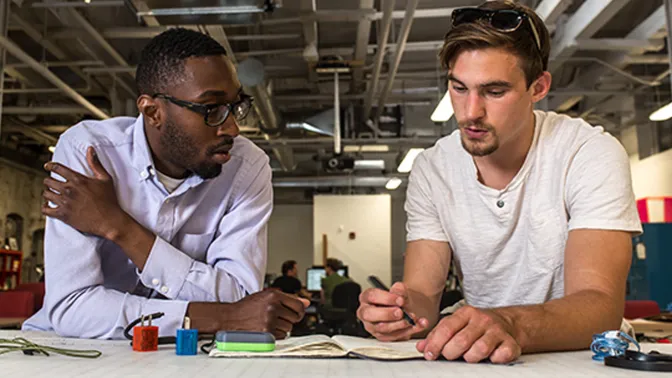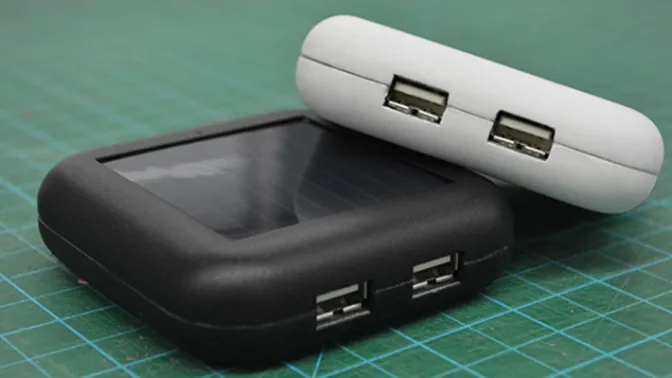
Here Come the SPORs
A year after the successful funding of its Kickstarter campaign, SPOR’s chargers are soaking up sunlight and turning it into clean energy that fuels some of our most precious material assets — our mobile devices.
SPOR has shipped thousands of chargers to consumers all over the world — including 150 special-edition 3-D-printed chargers purchased by Drexel LeBow alumna Dana Dornsife and her husband David and donated to World Vision’s water sanitation team in Ethiopia. These workers often lack access to reliable power sources, but can now utilize SPOR Charger’s solar panel to keep their phones working.
After sourcing their components during two trips to China and finalizing their product via trial and error, the large World Vision order was the first fulfilled. “It was a crash-course in production. In 150 units alone, we dropped the assembly time from 12 minutes down to four,” says SPOR CMO Mark Donohue ’14, who was born and raised in London and came to Drexel on a soccer scholarship.
Next, SPOR got to work fulfilling 273 more orders for 3-D-printed chargers, followed by 2,104 orders for chargers that don’t utilize 3-D-printed cases. This part of the process was local: SPOR sourced injection-molded cases from Echo Molding Inc. in New Jersey. It is now in the final stages of packing and mailing the last of its Kickstarter orders.
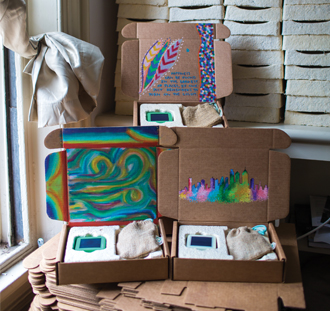
SPORs ready for shipment in custom packaging
As envisioned, the SPOR team has been assembling the chargers in their home/workspace about 10 blocks west of Drexel’s campus, with the help of some friends. David Hunt, the suave strategist behind the SPOR Kickstarter campaign, recently accepted a position at Drexel LeBow as the program manager for BRIDGE (which stands for [Building Relationships In Diverse Group Experiences). SPOR is now being run by co-founders Donohue and CEO Jason Browne ’14, and CTO Adrian Delta, who is a recent electrical and computer engineering graduate from Worcester Polytechnic Institute. They also employ Drexel electrical and mechanical engineering majors as co-ops and various friends who volunteer their time to SPOR simply because they have an interest in the project.
Their row home is filled with various SPOR charger guts, boxes and packaging materials. They hold “art parties” on Thursday nights, when artist friends stop by to paint whatever they feel inspired to on boxes that will soon ship with chargers inside.
While working to fill orders, SPOR has continued to innovate, add value and embody the brand promise to “achieve symbiosis between technology and nature.” This approach is epitomized in the perfect protective packaging material for their chargers: It is made from fungal mycelium (essentially, mushroom materials), which acts like a glue when combined with agricultural waste. Best of all, this material biodegrades very quickly. Jason says it cost only slightly more than traditional packaging, typically made from virgin plastics — and staying true to the brand is worth the modest additional cost.
They also partnered with a Vermont startup called CB Sacks that upcycles burlap coffee bags from around the world into stylish carrying cases. Here, they saw another opportunity to add value and exemplify the brand at only a small additional cost. The cases are automatically included with each SPOR charger.
SPOR’s use of 3-D printing means less plastic waste as well as the ability to make products more adaptable. It also paves the way for SPOR’s open-source vision — the brand’s key differentiator. Open source means that SPOR provides universal access to their product’s design blueprint and distributes that blueprint via libraries for design such as YouMagine and Thingiverse. Proponents of open-source networks argue that the collaboration, transparency and rapid prototyping that occur within are proven catalysts for innovation.
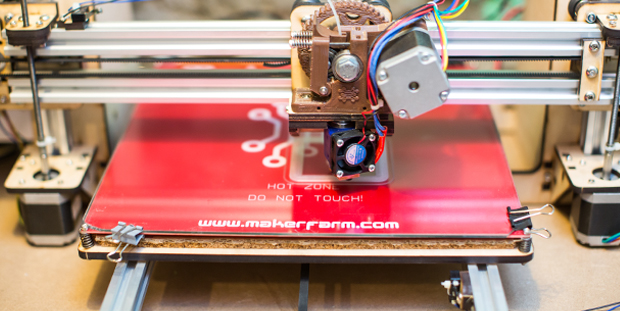
3D Printer building a SPOR
In terms of modifying the flagship charger, Jason says adding little things like a carabiner or a suction cup are simple mechanical design changes that can make their product different, and perhaps more useful for certain people, without much extra work. Jason explains: “Whereas normally the process of making little changes like these in a large company would be a long-term project, we can do it immediately.”
Their open-source approach also gives them an edge because it attracts very smart people who freely provide valuable ideas to their brand. “People who excel don’t just look for a paycheck,” Mark says. “They look for something that’s going to challenge them. They look for something that wasn’t there, that they can put a little bit of themselves into. … At the end of the day we are just three or four minds behind this, so why not get feedback from the people who are actually using our stuff?”
The team envisions an offering in the near future where they would just sell the guts of a charger at a lower cost than an assembled one. The guts of a SPOR are made up of three individually sourced, hand-assembled components: a .4W solar panel, a 5200mAh Lithium Ion battery and a circuit board designed from scratch by their CTO, Adrian. The idea is that customers with access to a 3-D printer could download the case design from an open-source website, print their own shell and assemble their charger.
“There are not too many products geared towards the revolution we see taking place in advanced manufacturing like 3-D printing,” Jason says. “And that’s what we’re putting ourselves in a position to do. We’re saying download our stuff. Change it. Mix it up.”
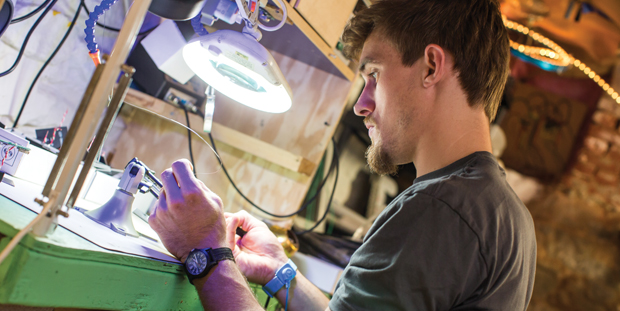
Jason Browne welds the interior mechanisms of a SPOR
“We aren’t engineers; we both graduated in finance and entrepreneurship,” Jason says. “If we can learn how to build this stuff, anyone can. We’ve taught 9-year-old kids how to solder and print. If you don’t understand the world around you, you can become fearful and submit to it. And you can let the world convince you that you don’t know anything.”
At the end of the day we are just three or four minds behind this, so why not get feedback from the people who are actually using our stuff?“
One thing the SPOR team has figured out thus far is that although the small solar panel on the charger will passively keep devices powered up longer, those wanting power in remote areas will need larger panels. They are currently developing a product that will give a boost to the product line by providing more surface area to absorb sunlight. They say this will be useful to customers who want to do things like go camping in remote places without losing access to their mobile technology.
In the long term, SPOR hopes to create large-scale solar powering products that will power bigger electronic devices — “everything up to Elon Musk’s Tesla Powerwall,” says Mark — via new, more powerful USB technology. Currently, bringing solar technology into a home is an expensive project that entails high startup costs due to connecting the solar panels to the electric grid. There’s no other way to feed that energy into a home — but with these improving USB technologies, there soon will be.
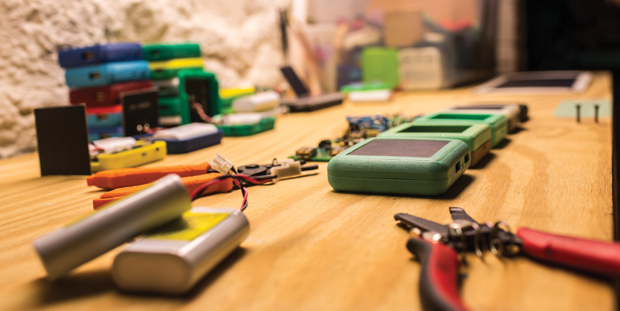
“A business plan isn’t a business. It’s just an idea of what a business could be,” says Jason. “When we initially wrote the business plan for SPOR, sure it had long-term plans for profitability. But really, we knew nothing about building a SPOR. We had no idea what it would take — what we would outsource and what we could do ourselves.”
Now that they have an idea of what they can do, they remain more committed than ever to local manufacturing — which makes profitability more difficult in the short term. But they can see the process becoming cheaper and more efficient in the near future.
“We are building an energy brand around ‘I need this now, build it for me,’” Mark says. “We are educating our customers that they can buy products that are an extension of themselves, rather than cut corners by buying another generic product that was made in China and sat on a shelf for six months.”
Jason chimes in: “We make battery chargers, but with our current suppliers we can also make things that you haven’t even thought of yet. We’re always asking how we can make SPOR more useful, whether that’s adding data storage, improving charging capabilities or integrating software.”
Right now the team sees SPOR as a localized growth opportunity. “We want to really maximize what we can do here in this city, with the resources that we have available to us. We owe a lot to Philly and want to prove to others that building products here is not only doable but also an opportunity to thrive.”
Photography by Ben Weldon
